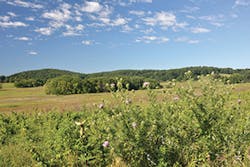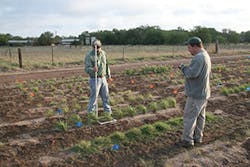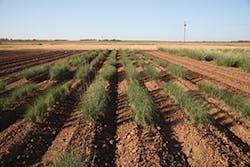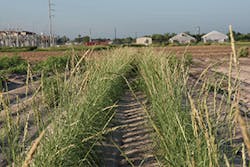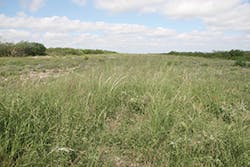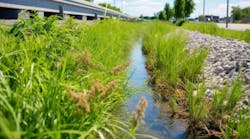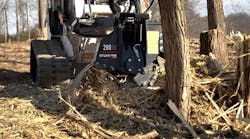Almost anyone familiar with American culture can envision some of the iconic locations in Philadelphia—from Independence Hall, the home of the Liberty Bell, to the art museum stairway made famous in the Eye of the Tiger scene from Rocky, to the Philadelphia Canoe Club located on the banks of the Schuylkill River just beyond downtown. The city is one of the most picturesque of all major cities on the East Coast. However, “The land is degraded” as a result of centuries of intense urbanization, says Jess Slade, horticulturist with the Morris Arboretum in the Chestnut Hill neighborhood on the outskirts of Philadelphia. Nonetheless, she believes it can be even more beautiful and has plans to make that happen, at least for one small pocket of the city.
Slade is a natural lands horticulturist at the Morris Arboretum. Managing about 40 acres of the grounds, she does a lot of invasive plant management and a lot of planting. She takes care of the floodplain that includes about 15 acres of floodplain meadows, a restored wetland, and an upland woodland fragment that abuts a tributary of the Wissahickon Creek and the Papermill Creek, both of which are ultimately tributaries to the Schuylkill River in the Delaware River watershed. “Because we have the creek running through, I’ve been doing a lot of management, including planting and trying to restore forest along the creek to help with erosion.” Describing the challenge, she says, “It’s a small creek, but because it’s in an urban area, when it rains a lot we get big floods, so we’re trying to manage for that and help as much as we can.”
One of the projects she manages is a meadow restoration adjacent to one of the arboretum’s wetlands. “It was full of invasive species. We worked for two years to get those under control, and this past season we seeded it with a custom native seed mix that we worked with Ernst to develop.” She says Ernst Conservation Seeds worked with the arboretum to develop a unique seed mix of species native to the Pennsylvania piedmont, which includes the Philadelphia region of southeastern Pennsylvania where the meadow is located. Slade describes the mix as “wildflowers and native grasses and sedges.” She explains further: “All of the planting I do is native species. The idea is to provide wildflowers that can provide food for the birds and habitat for the pollinators. In everything we do in our management, we try to do what will be best for the wildlife.”
She adds, “Ernst Conservation Seeds can work with anybody to develop mixes that are custom to the site. A lot of the seed we get from them is from Pennsylvania ecotype, so it’s custom. I understand they can do that for a lot of different places.”
Through a series of telephone calls and email exchanges, Slade was able to convey the needs of the arboretum’s meadow restoration project, and from that correspondence Ernst Seeds was able to develop a mix to meet those needs.
Seed evaluation at the Caesar Kleberg Wildlife
Research Institute
While Slade concedes that replicating pristine historical conditions at the site is not practical, she was able to employ a rationale to seed selection to try to approximate a presumed native state. Although she didn’t perform an official plant census survey, she says the area is adjacent to a previous wetland restoration that the arboretum had completed 15 years earlier, and which may be showing signs of native rebirth. She explains: “It’s on an edge zone of wetlands. So I tried to get some of those edge-zone facultative plants for the mix.” In addition, she says the plants that were chosen were from a list created by an arboretum botanist that was based on a survey of a wetland of similar geology in the region. Summarizing the obstacles to achieving a pristine restoration, she says, “We don’t know what was here historically; the land has changed a lot. So it’s a guessing game. We’re trying to do the best we can. It’s not exactly a restoration, but we are trying to use plants that we think would be here on their own.”
Many disturbed landscapes face similar challenges, she says. “There are always invasives.” One of the biggest problems at the arboretum site has been the porcelain berry. “The harm is that it outcompetes other plants; it covers the ground and then it climbs up shrubs and trees, and it can kill them by shading them out. It grows more quickly and aggressively than everything else, so there are some areas where all that’s left is porcelain berry.” She laments, “Invasive species affect our ecological communities because they disrupt the native species, and the biodiversity is lowered by them, and they are not as valuable to pollinators and wildlife as our native species are.” To help address the issue, she says, the area was treated with herbicides just before seeding.
Plant evaluations at the Kleberg Wildlife Research Institute
Confusing the Natives
Slade considers the term “native” to be a source of confusion. She believes the term “native plant” is too loosely used. “A lot of plants that people are excited about—they’ll be popularized and people will say, ‘We love this native species,’ but when you get down to the site or the region, it’s not always true.”
However, she feels that Ernst Conservation Seeds helps bring clarity to the topic “by being able to specify local ecotypes when appropriate.” When a seed derives from a local ecotype, Slade says, “We know that the species developed here, and it might have slight variations that are based on being in Pennsylvania as opposed to Kansas. Also, if they have a mix that says it’s Piedmont Pennsylvania, that means they are species that are from this area, as opposed to plants that we think of as native that really aren’t native right here. Like Echinacea—a lot of people think, ‘Oh, that’s a native plant,’ but it’s not native to this part of Pennsylvania.”
She says, “I worked with Ernst because they’re pretty local, based in Pennsylvania, and I knew that they had seed that was available for this region particularly. Other seed companies that I am aware of are in different parts of the country.” Although she says producers in the Midwest or in the South may be able to offer some of the same species, “It’s nice to have somebody that’s a bit more local. On their seed list, Ernst says they have the Pennsylvania ecotype—I like that.”
According to Slade, there are resources available that can help narrow the search for what might be reasonably considered native to any region. She mentions the Biota of North America Program that can be found at www.bonap.org and a separate list she sometimes refers to when considering mixes for the Philadelphia area. “Tim Block created different lists; there’s one for Philadelphia, maybe some other counties. He has also published a book called The Plants of Pennsylvania. You can look through there and learn about a species and get information about a plant, such as where it’s found and basic information about its natural distribution—saying very loosely, for example, ‘This is common in the south.’”
Wishful Planting
When working with Ernst Conservation Seeds, Slade says, she started with “a wish list, and they made edits and helped decide how much of each species we’d need in the mix based on how much the seed weighs and how many seeds per pound, and also how aggressively different species would grow. That’s something I would never know, so I thought it was really easy because they were very helpful, especially in making the mix and making changes.” Although designing the mix took an extended period of discussion and analysis, after the decisions were finalized, “the actual mixing and shipping of it was very fast—within a week.”
Before its first full season of growth, the arboretum’s incipient meadow restoration had already begun turning heads, but not so much for its beauty, she says. After the removal of unwanted plants, the area just looked bare, “like a farm field.” But, she notes, “It was close to the entrance, so people were curious about what we were doing. Other nearby meadows were just standing and growing, but this one looked different with the changes, so visitors have been curious.” At the same time, she says, “There is definitely germination; it’s just that the plants are really small. And with some species, you see more of them than others. The way that we have been managing the areas that we’ve seeded is we have been mowing them regularly through the season so that the annual weeds like foxtail grass get chopped back, and younger perennial species don’t get shaded out.”
She adds, “It doesn’t look like much yet. To most people, it just looks like a mowed area. I think it will be a couple of years before it starts to look like something aesthetically pleasing to our visitors. We have a lot of regular visitors, so when they come here and something’s different, they notice the change.”
Slade nonetheless loves watching things grow. “I don’t do seeding all the time; I’m just a horticulturist. I get to do seeding sometimes, when I’m lucky.”
Driving Change in the Back Country
While natural beauty often brings out the best in people, sometimes it highlights other aspects of their personality. The US Forest Service has maintained a policy of allowing drivers of off-highway vehicles to access certain parts of National Forest lands for recreation, but as one might expect, some people literally take things too far.
In Colorado, in the region of the Continental Divide, there are hundreds of miles of four-wheel-drive roads. Morgan Crowley, restoration and invasive species program manager for Wildlands Restoration Volunteers (WRV), says many of them are recreational. “Some of them are legal, many of them are illegal. A lot of them are overused.”
Sometimes, she says, “they become unsafe themselves, sometimes with so much erosion that the roads have massive gullies in the middle of them. But primarily, they are impacting water quality, so we go in and restore them. In some cases, they are roads established by the Forest Service, but a lot of times it’s just off-road areas where people in these souped-up jeeps are just driving all over the place,” confides Crowley.
According to Crowley, because of funding constraints, the National Forest Service is seeking to close dozens of these roads because it doesn’t have the money to maintain them. “If they are not maintained, they are falling into more and more degraded states,” she says.
In her work, Crowley coordinates volunteers working all over Colorado doing ecological restoration projects. The organization’s mission is twofold, with equal weight on both restoring the land—by doing anything from high alpine road closures with a lot of erosion control, to wetland restoration, streambank stabilization, and post-fire restoration—and native seed collection and invasive species removal. In addition, she says, “We’ve had a lot of flood restoration, especially in the front range.” While the nonprofit operates in Colorado and parts of southern Wyoming, the bulk of its projects are within a two- to three-hour drive of the Denver metro area.
With a database of over 3,500 active volunteers who, Crowley says, come out to work on at least one or two projects every year, the group includes social events, community building, and leadership training in everything it does. “That way we can run these projects with the minimal staff, but huge numbers of volunteers,” she says.
“We run about 120 projects every season from March to November. We are running projects virtually every weekend and projects during the week as well,” she notes.
Recently, WRV partnered with the Forest Service to facilitate a road closing and habitat restoration on a 2-mile stretch of illegal alpine road in Park County, CO.
On the Road to Recovery
“This road was very steep and at points went straight up the fall line of the mountain. There was a lot of erosion going on because it was poorly maintained, and the water was basically flowing straight down the road because it’s the path of least resistance.” As a result, Crowley says, “There was a lot of sediment deposited in the creeks below, and that was impacting drinking water quality for nearby towns like Fairplay.”
The problem, Crowley says, was that “the road had been closed, but people were still using it. We came in to help the Forest Service restore it. We first looked at this road early in the spring. We walked every foot of it with a team of WRV staff and the Forest Service, as well as with volunteers with professional experience doing restorations serving as technical advisors.” Crowley explains that the road was staked out in 200-foot sections to organize a plan of section notes and instructions for restoration volunteers. Restoration ecologists accompanied the volunteer teams on their survey of the site to help evaluate which treatments would be appropriate for each section and then wrote up a plan indicating where a range of treatments would be applied, including erosion fabric and seed, or seed and wood straw, or seed raked in alone.
To begin the restoration process, she says, “We had a contractor with a backhoe go in and rip up all of the road. They’d go in and loosen those soils up so that they can’t be driven on, and he is also able to change the drainage pattern. For sections of the road that were just straight up the fall line, he would go in and dig in and build in water bars, so that in places where it was steep the water could be drained off to the side. We changed the underlying structure of the road with the backhoe, and then the volunteers would go in and do the treatments that are prescribed in our section notes.”
The road spanned an elevation ranging from 10,500 feet to 12,000 feet at the top. “We reseeded every square foot of that road using erosion control fabric to hold the seed down as well as raking it in. At certain points, especially at the high alpine when we were up on the continental divide, because there was not much tree cover, we used erosion control fabric because it was less likely to blow away.”
White tridens
She says, “We used Biosol in a lot of those places. We used it in certain places where it seemed the soil was poorer.” Along with the seed mix, volunteers also applied a mycorrhizal inoculant from Bowman Construction “to jumpstart the production of fungi in the soil.”
She adds, “We’re doing another similar project in a different drainage next year. This is a fairly common type of project for us to get involved in. We use Biosol on a lot of our projects. This year we used an enormous amount on flood recovery projects out in Lyons. We often use Biosol when the soils have been either impacted by overuse, as in the case of the high alpine road, where it is not recovering, or where it’s not recruiting native plants, or in cases like a flood, where it’s been inundated with all sorts of things and it is mainly growing weeds.”
Jeffery May, Wildlands Restoration volunteers coordinator, says Biosol has a lot of advantages over standard industrial fertilizers and is especially user-friendly for volunteers without a lot of agronomic experience. “One, it’s organic; it retains water; it tends not to leach as much as other products. It’s been effective for us. It’s a nitrogen-rich fertilizer. It’s easy to come by and easy to spread, and it disperses very evenly. It doesn’t need to be mixed in a slurry, and you don’t need any mechanical spreaders for it. It’s not as dirty and nasty.” However, he concedes, “It’s definitely stinky when it gets wet.”
Crowley notes that Biosol is well matched to the challenges faced in revegetating high alpine sites, where one of the objectives is to avoid leaching nutrients into receiving waters that are used downstream as drinking water. “When we use these products, we’re using them in areas where there is erosion going on, and usually the erosion is impacting water quality, so we wouldn’t want to use fertilizers that are going to leach into the water.”
Crowley emphasizes Biosol’s ease of use as a form of fertilizer and soil enhancement. “We measure it out and we’ll give it to the volunteers. We usually have small one-gallon buckets, and we weigh them out ahead of time, so we know that this bucket, at this line, is how much should go over this much area, and the volunteers spread it. It’s like pellets—you can just grab a handful and throw it on the ground.” May adds, “It’s kind of like chicken feed; it’s distributed the same way you distribute seed.”
The only difference is that “seed needs to be raked in,” points out Crowley. “Biosol needs to stay on top because it breaks down better if it’s exposed to oxygen.”
To hold the soils and seed in place until germination, WRV used an erosion control fabric composed of coconut fiber. “It’s 100% biodegradable. Some of the other erosion control blankets have a plastic netting on them that holds them together, but the one we use is all coconut fiber,” says Crowley. “It takes a few years to break down, but most of our partners want that, as opposed to something that is going to leave little bits of plastic.” She favors a naturalistic approach to securing the fabric as well. “Sometimes we’ll use staples to hold it on the ground; other times we use stakes, sometimes rocks.” As specified by the section plan, she says, volunteers also used another product called WoodStraw, which she says is significantly less likely to blow away than regular straw, while being “entirely unlikely to have weeds.” She explains: “With straw, you have to get certified weed-free straw, and even then you still might get weeds.” In contrast, “WoodStraw is just chipped wood in bales.”
She says, “We usually see the grasses are growing in within a year. We just did one restoration on Trout Creek and heard from our partners that the grasses were starting to come in pretty well. This time, we used primarily grasses and yarrow, which is remarkably adaptive; it grows from low elevations to extremely high elevations. It’s a great one to put into a seed mix where we’ve got a lot of variation.”
Replicating Diversity for the Future
The beauty of America is in its diversity. There is a lot of diversity in plants too, even within the same species, but often you wouldn’t know it by looking at them. Forrest Smith of the Texas Native Seeds Program says his organization serves as the research branch of the Caesar Kleberg Wildlife Research Institute, with a mission to collect, increase, and commercialize locally adapted native seed sources. He says it’s hard to pinpoint variability in plant genotypes, but that nevertheless these imperceptible variations can make all the difference in the success or failure of a native seeding project. “Somebody that is very familiar with varying ecotypes side by side could probably tell some differences, but often there is very little visible difference. That’s where a program that is tracking seed origin—making sure the seed company is growing the exact strain and marketing it to the right region and to the right customer base—becomes really important.”
He says, “We try to do seed source development on a regional basis.” The Texas Native Seeds Program divides the state of Texas into six project regions, working to collect seed from wild stands of native species, increasing that seed in an agronomic setting, and then “licensing the production of seed to companies like Bamert Seed,” says Smith.
Having access to local-genotype seeds can make or break a restoration project. “One of the clearest of examples is apparent in mid-autumn,” he says. “If you took a very common type of plant such as little bluestem, which grows from Mexico to Canada, there are as many variants as there are different types of people. There is a lot of variability.” According to Smith, plants that are native to south Texas would, at mid-autumn, just be starting to produce seed and flower, “because in south Texas you don’t get a frost until December.” In Nebraska, he says, that same species of plant would have flowered and produced its seed back in August or September as an adaptation to the seasonal onset of frost in late September or early October there. He explains, “A lot of that adaptation is genetically based, adapted over long periods of time by those different plants growing in different environments. If you took that seed of little bluestem from south Texas and planted it in Nebraska, those plants would never reproduce. They would frost before they had a chance to initiate seed set.” Conversely, he says, if variants of the plants from Nebraska were raised in south Texas, they would “attempt to flower and set seed in the middle of summer, when it was too hot for them to be able to do so. The plants wouldn’t reproduce and wouldn’t do well. Generally, if you move plants well beyond their adaptation range, they’ll die within two to five years.”
Kleberg Institute
He adds, “Unfortunately, there are a lot of native seed sources that are marketed and the companies who sell them really have no idea where that material originated or where it was reasonably adapted to. The key concept is that native is not native everywhere. For any given native plant species, any individual plant is not going to grow everywhere that species occurs. You need relative similarity between its origin and the planting site. That concept is well known in plant ecology in the crop world. With corn, for example, you have thousands of different varieties of corn that are selected for growth in certain regions, certain day length, and certain soils.” He believes the same variability holds for native plants used for habitat restoration and that similar considerations should be applied.
Bamert Seed is expert in facilitating the tracking and certification of local genotype seeds, he says. “They are a licensed producer of several selections that we’ve made, and have been for five years plus in some cases. When we have a seed selection that is increased to the point that we think it’s ready to be commercialized, we’ll ask their company and other companies for production proposals to gather their interest, ability, and capacity to take that seed selection to market. Then we’ll negotiate a license agreement and distribute the seed that we’ve produced to them to establish it for production. All throughout that process, there is very close cooperation in not only transferring seed but also transferring production methodology and quirks about pest control or fertility requirements. Through a combination of field projects such as actual roadside seeding projects, in the actual setting of roadside test plots, coupled with research farm studies, we may be looking at things like the appropriate seeding rates, or season of seeding, and the production methods like harvest dates, different types of harvest equipment, different ways to clean and process the seed to make it useable or to break dormancy so it can be planted and stand relatively quickly.” In addition, he says, “Almost every plant has some disease or pest issue that you’ll stumble upon at some point in the process that you’ll have to take a hard look at.
“We’re assisting them in being successful in producing it, and they are often taking 10 pounds of seed to the level of hopefully thousands of pounds of production.”
As Smith and many others have said, “Texas is a big place,” containing many widely variable ecological niches. But a thread binding all of Texas together is a growing appreciation of the value of native habitats and a focused desire to restore native plant communities for both economic and intrinsic reasons. Meanwhile, the Texas Native Seeds Program has been at the center of a growing understanding of diversity and its role in establishing native plant seed sources to enable success.
